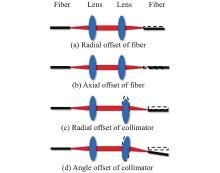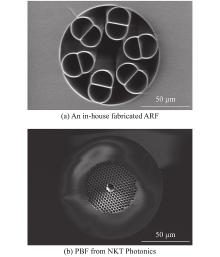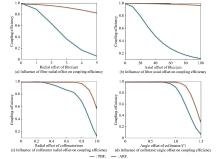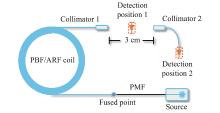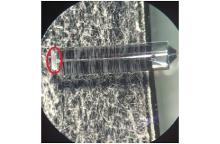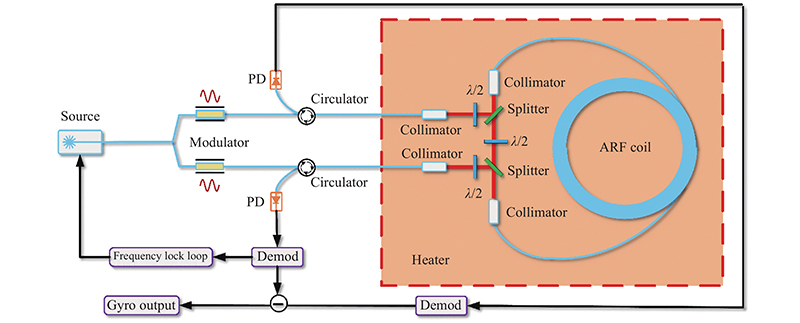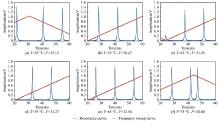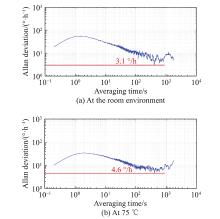| 1 |
MEYER R E, EZEKIEL S, STOWEETAL D W Passive fiber-optic ring resonator for rotation sensing. Optics Letters, 1983, 8 (12): 644- 646.
doi: 10.1364/OL.8.000644
|
| 2 |
BENABID F, KNIGHT J C, ANTONOPOULOS G, et al Stimulated Raman scattering in hydrogen-filled hollow-core photonic crystal fiber. Science, 2002, 298 (5592): 399- 402.
doi: 10.1126/science.1076408
|
| 3 |
KOLYADIN A N, KOSOLAPOV A F, PRYAMIKOV A D, et al Light transmission in negative curvature hollow core fiber in extremely high material loss region. Optics Express, 2013, 21 (8): 9514- 9519.
doi: 10.1364/OE.21.009514
|
| 4 |
DANGUI V, DIGONNET M J F, KINO G S Laser-driven photonic-bandgap fiber optic gyroscope with negligible Kerr-induced drift. Optics Letters, 2009, 34 (7): 875- 877.
doi: 10.1364/OL.34.000875
|
| 5 |
SONG N F, WANG X Y, XU X B, et al Measurement of the Verdet constant of polarization-maintaining air-core photonic bandgap fiber. Sensors, 2017, 17 (8): 1899- 1904.
doi: 10.3390/s17081899
|
| 6 |
BLIN S, DIGONNET M J F, KINO G S Noise analysis of an air-core fiber optic gyroscope. IEEE Photonics Technology Letters, 2007, 19 (19): 1520- 1522.
doi: 10.1109/LPT.2007.903878
|
| 7 |
GIRARD S, OUERDANE Y, BOUAZAOUI M, et al Transient radiation-induced effects on solid core microstructured optical fibers. Optics Express, 2011, 19 (22): 21760- 21767.
doi: 10.1364/OE.19.021760
|
| 8 |
ROBERTS P J, COUNY F, SABERT H, et al Ultimate low loss of hollow-core photonic crystal fibres. Optics Express, 2005, 13 (1): 236- 244.
doi: 10.1364/OPEX.13.000236
|
| 9 |
DUGUAY M A, KOKUBUN Y, KOCH T L, Antiresonant reflecting optical waveguides in SiO2-Si multilayer structures. Applied Physics Letters, 1986, 49(1): 13−15.
|
| 10 |
LITCHINITSER N M, ABEELUCK A K, HEADLEY C, et al Antiresonant reflecting photonic crystal optical waveguides. Optics Letters, 2002, 27 (18): 1592- 1594.
doi: 10.1364/OL.27.001592
|
| 11 |
GAO S F, WANG Y Y, DING W, et al Hollow-core negative-curvature fiber for UV guidance. Optics Letters, 2018, 43 (6): 1347- 1350.
doi: 10.1364/OL.43.001347
|
| 12 |
YU F, WADSWORTH W J, KNIGHT J C Low loss silica hollow core fibers for 3−4 μm spectral region. Optics Express, 2012, 20 (10): 11153- 11158.
doi: 10.1364/OE.20.011153
|
| 13 |
GAO S F, WANG Y Y, DING W, et al Hollow-core conjoined-tube negative-curvature fibre with ultralow loss. Nature Communications, 2018, 9, 2828.
|
| 14 |
JASION G T, BRADLEY T D, HARRINGTON K, et al Hollow core NANF with 0.28 dB/km attenuation in the C and L bands. Proc. of the Optical Fiber Communications Conference and Exhibition, 2020, 19629480.
|
| 15 |
JASION G T, BRADLEY T, HARRINGTON K, et al 0. 174 dB/km hollow core double nested antiresonant nodeless fiber (DNANF). Proc. of the Optical Fiber Communications Conference and Exhibition, 2022, 21687486.
|
| 16 |
RAVAILLE A, FEUGNET G, DEBORD B, et al Rotation measurements using a resonant fiber optic gyroscope based on Kagome fiber. Applied Optics, 2019, 58 (9): 2198- 2204.
doi: 10.1364/AO.58.002198
|
| 17 |
SUO X, YU H C, LI J, et al Transmissive resonant fiber-optic gyroscope employing Kagome hollow-core photonic crystal fiber resonator. Optics Letters, 2020, 45 (8): 2227- 2230.
doi: 10.1364/OL.388274
|
| 18 |
TARANTA A, FOKOUA E N, MOUSAVI S M A, et al Exceptional polarization purity in antiresonant hollow-core optical fibres. Nature Photonics, 2020, 14, 505- 510.
|
| 19 |
MICHAUD-BELLEAU V, FOKOUA E, BRADLEY T, et al Backscattering in antiresonant hollow-core fibers: over 40 dB lower than in standard optical fibers. Optica, 2021, 8 (2): 216- 219.
doi: 10.1364/OPTICA.403087
|
| 20 |
DING M, KOMANEC M, SUSLOV D, et al Long-length and thermally stable High-Finesse Fabry-Perot interferometers made of hollow core optical fiber. Journal of Lightwave Technology, 2020, 38 (8): 2423- 2427.
doi: 10.1109/JLT.2020.2973576
|
| 21 |
SANDERS G, TARANTA A, NARAYANAN C, et al Hollow-core resonator fiber optic gyroscope using nodeless anti-resonant fiber. Optics Letters, 2021, 46 (1): 46- 49.
doi: 10.1364/OL.410387
|
| 22 |
JIAO H C, FENG L S, WANG J J, et al Transmissive single-beam-splitter resonator optic gyro based on a hollow-core photonic-crystal fiber. Optics Letters, 2017, 42 (15): 3016- 3019.
doi: 10.1364/OL.42.003016
|
| 23 |
JIAO H C, FENG L S, LIU N, et al Improvement of long-term stability of hollow-core photonic-crystal fiber optic gyro based on single-polarization resonator. Optics Express, 2018, 26 (7): 8645- 8655.
doi: 10.1364/OE.26.008645
|
| 24 |
PETROVICH M N, POLETTI F, BRAKEl A, et al Robustly single mode hollow core photonic bandgap fiber. Optics Express, 2008, 16 (6): 4337- 4346.
doi: 10.1364/OE.16.004337
|
| 25 |
JIN D R, CHEN Y, LU Y, et al Neutralizing the impact of atmospheric turbulence on complex scene imaging via deep learning. Nature Machine Intelligence, 2021, 3, 876- 884.
doi: 10.1038/s42256-021-00392-1
|
| 26 |
SUN S, SHI W, SHENG Q, et al Polarization-maintaining terahertz anti-resonant fibers based on mode couplings between core and cladding. Results in Physics, 2021, 25, 104309.
|
 ), Hui LI1(
), Hui LI1( ), Changkun FENG1, Lishuang FENG1,2,*(
), Changkun FENG1, Lishuang FENG1,2,*( ), Shoufei GAO3(
), Shoufei GAO3( ), Yingying WANG3(
), Yingying WANG3( ), Pu WANG4(
), Pu WANG4( )
)


